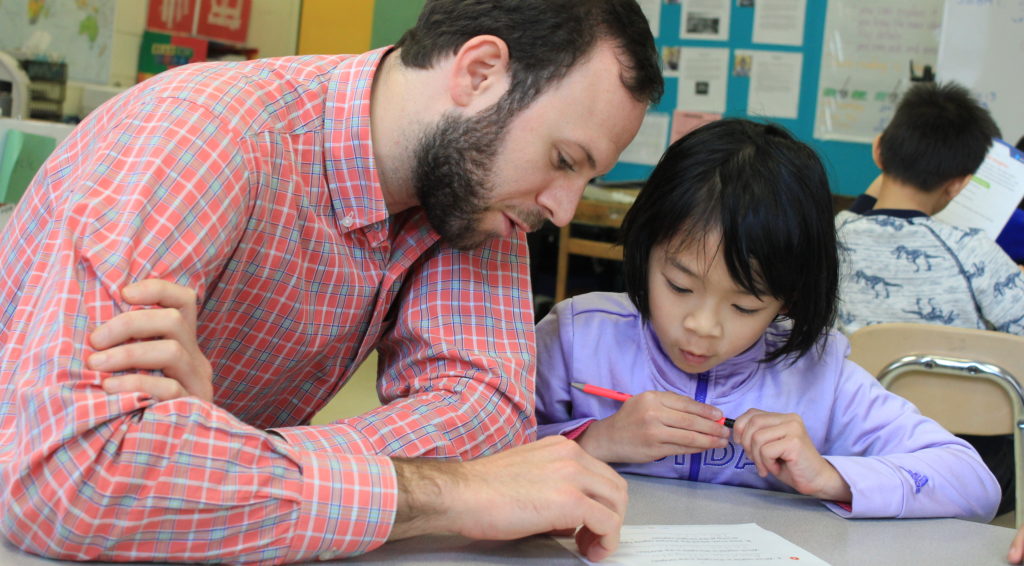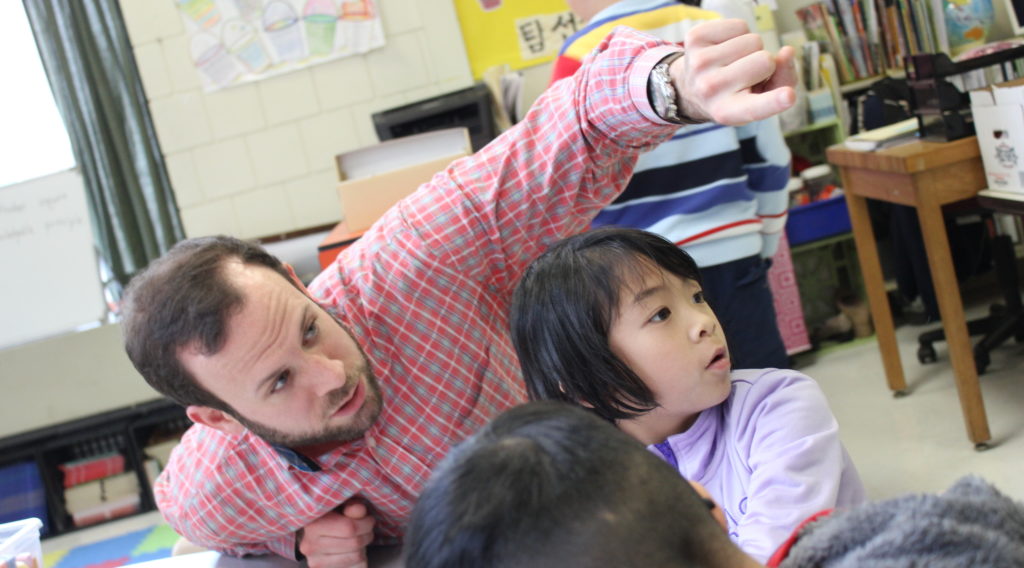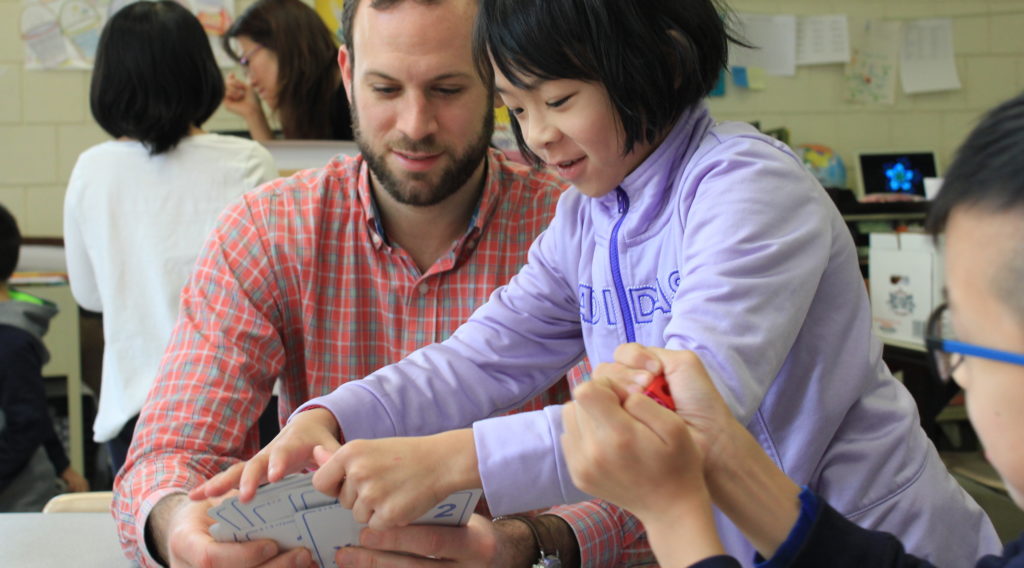 Greg Mahar’s height is written on the whiteboard in front of Stephanie Tham’s third grade class at the Josiah Quincy Elementary School. It’s being used as a way to create a word problem for the students, but it’s also a sign from Ms. Tham that Greg has become an important and trusted member of the class.
Greg Mahar’s height is written on the whiteboard in front of Stephanie Tham’s third grade class at the Josiah Quincy Elementary School. It’s being used as a way to create a word problem for the students, but it’s also a sign from Ms. Tham that Greg has become an important and trusted member of the class.
Despite only being in the classroom for one hour a week, Greg is an essential element to Ms. Tham’s work as an educator; as a model academic mentor, Greg has the proven ability to take students who are falling behind and help them achieve. In fact, last year Greg’s mentee, Anna, went from being unable to solve simple multiplication problems to earning the highest test scores in the class.
How can a mentor help a student so effectively? What makes Greg a valuable member of the classroom is that, as an experienced mentor and older brother, he intuitively understands the steps that can help his students excel most.

1. Work closely with the teacher
Before Greg sits down with his student, Ms. Tham takes him aside to go over the day’s activities. This brief check-in goes a long way towards making sure everyone is on the same page.
There are several ways to approach math problems, so Greg and Ms. Tham work together to ensure that what he is teaching the children is consistent with Ms. Tham’s lesson. Greg pays close attention to the lesson when he arrives so he knows how best to help his students.
“What I like about Greg is that he’s using the same strategy that I am,” says Ms. Tham. “So, if I’m using a number line, and I’m asking the kids to use the same strategy, he’ll remind the kids to use the number line. He’s reiterating what I’m trying to teach. He, in a sense, is also a student in here.”

2. Meet the students where they are
An academic mentor with Boston Partners since 2016, Greg has worked with a number of students who have faced very different challenges. One of his previous students was talkative and easily distracted, which meant Greg was there to help her focus on her work. The following year, Greg’s student Anna was very shy and lacked confidence. Greg focused instead on teasing out the knowledge, and letting Anna find joy and confidence in success.
Other students, as Ms. Tham points out, have difficulty with language barriers that prevent them from understanding what is being asked. “They probably won’t understand what a lizard is”, she remarks to Greg, as she leafs through the day’s worksheet. “You will have to explain that.”
Finding out what a student needs is an important step, and that means building a relationship. This can be challenging, and Greg says it’s important to be careful and avoid condescension. “They’ll know they have the skills to do the work, and they know how to get the answer. But if you throw too much at them too quickly or give them too difficult a problem, or if you make it seem like you’re disappointed in them when they give a wrong answer, it will discourage them.”
“I can push them 80% of the way, and they will get the last 20%,” says Greg. “And next time, I will push 60%, and they’ll do 40%. I keep pulling back little by little. They don’t need to get it all on their own right away. Be positive and keep their spirits up.”
When talking about his mentoring approach, Greg emphasizes friendship and respect is at the core of his philosophy. “Students will take what you’re telling them a lot more seriously if you show you value them, if you treat them with respect. You have to treat them like adults. You have to treat them as equals.”

3. Build their confidence
Both Greg and Ms. Tham agree that building confidence is the most crucial step to student achievement. Greg uses Anna as an example to show how building confidence can unlock the knowledge that is already there: “She needed help with her multiplication tables, so I started with multiples of four. She was having trouble with 4 x 2. I was trying to ease her into it, but I could tell that a lot of it was confidence. It seemed like she knew the answer.”
Greg began to bring flash cards to the class and used them when he and Anna were done with the day’s work. Gradually, Anna began to get used to giving the answers more quickly and confidently.
“Once she found the confidence in her own skills and realized that she did know these answers, I think it really helped her want to work harder. To want to try. To do something other than guess the answer.”
Ms. Tham elaborates on how Greg accomplishes this with his students: “He’s just so encouraging. He’s always giving them high fives and saying, ‘you got it!’ I can sense that the kids feel very positive at the end of the session. The kids are much more confident and comfortable, because they know they are going to get help. They know that whatever the problem is, it’s going to be solved and it’s going to be right.”
By mastering these steps, Greg has established the type of mentoring relationship with students that pushes beyond academics. “At the end of last year my student gave me a card which she made on her lunch break,” he recalls. “I still have it on my desk. It says ‘Dear Mr. Greg, thank you for helping me with my math!’”
However, he finds the most rewarding part of his volunteer work is knowing that he helped a student find the confidence to succeed. “Knowing that kids are improving is so rewarding to me. That one-on-one attention means that I can see the impact. Knowing that those kids are improving or getting a little bit better in math and gaining confidence and feeling good about themselves, it’s rewarding in itself.”
As Greg is wrapping up with his students, Ms. Tham drops in on the session to see how the students have performed on their classwork. It is early in the year, but she is already impressed with the students’ progress — she even talks to Greg about adding another student to his group. With a wide smile she says, “maybe you can work your magic with them, too!”
